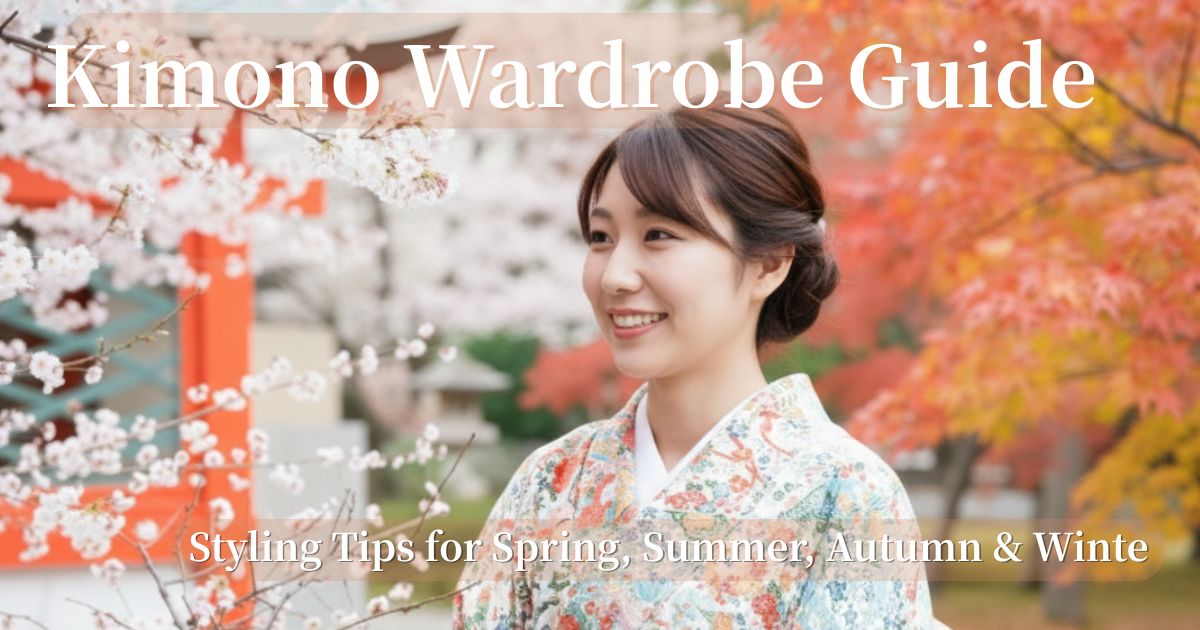Koromo-gae, the practice of changing one’s clothes with the seasons, is a tradition passed down through generations, closely tied to Japan’s climate and the changing of its four seasons.
Originating as a court ritual, this custom eventually spread to the lives of common people.
It’s more than just a practical adjustment for the weather; it reflects the Japanese appreciation for the seasons.
On this page, we’ve summarized the origins of koromo-gae, the basic rules for kimono, and flexible ways to incorporate this practice into modern life.
We hope these tips will be helpful for your seasonal kimono lifestyle.
What is Koromo-gae?
Koromo-gae is a Japanese custom of changing clothes to match the seasons.
Kimono are deeply connected to the four seasons, and they are changed to suit the climate and seasonal events—into an awase (lined kimono), a hitoe (unlined kimono), or an usumono (lightweight kimono).
From ancient times, this practice began as a court ritual on April 1st and October 1st, where everything from clothing to furniture and decorations was renewed. It was considered an important annual event.
Koromo-gae is a piece of practical wisdom for adapting to Japan’s hot and humid climate, and it’s a custom that took root thanks to the rich sensibility of the Japanese people, who value the changing seasons.
For kimono, the basic rule is to wear an awase from October to May, a hitoe in June and September, and an usumono for midsummer in July and August.
In recent years, with the widespread use of air conditioning, more people are enjoying a flexible approach, such as wearing an unlined wool kimono in the middle of winter.
Even so, the tradition of koromo-gae—which expresses coolness and warmth by incorporating natural seasonal elements—is something we should cherish as a core part of kimono culture.
Basic Rules for Kimono Seasonal Changes
Koromo-gae is a tradition that has long been established, emphasizing the importance of dressing for each season.
For kimono specifically, the practice is largely divided into three categories based on the tailoring and materials used.
● Awase (Lined Kimono)
Wearing period: October to May
Features: This kimono has a lining. It’s suitable for colder seasons and is the most commonly worn type of kimono for the longest period of the year.
● Hitoe (Unlined Kimono)
Wearing period: June and September
Features: This is a single-layer kimono without a lining. It’s perfect for times when it feels a little humid or hot, such as during the rainy season or early autumn.
● Usumono (Lightweight Kimono)
Wearing period: July and August
Features: This kimono is made from highly breathable, sheer materials like ro, sha, or linen. It’s designed to create a cool, refreshing look during the height of summer.
Seasonal Flair with Accessories
Koromo-gae isn’t just about the kimono itself; it’s a refined touch to also reflect the seasons through your accessories.
● Obiage & Obijime
In summer, use sheer materials like ro and sha.
In spring and autumn, use materials such as chirimen (crepe) or silk, and incorporate seasonal flowers or colors to make your outfit stand out.
● Zori & Bags
In mid-summer, choose light colors like white or pale shades for a refreshing look.
In autumn and winter, match your outfit with deeper colors or materials like enamel to create a seasonal feel.
● Haori & Shawls
In spring and autumn, wear lightweight haori or stoles. In winter, use thicker haori or shawls to stay warm while looking stylish.
Accessories are small, making it easy to incorporate seasonal colors and materials, adding a subtle accent to your koromo-gae.
Modern Koromo-gae: Toward a Stress-Free Kimono Lifestyle
The strict rules for koromo-gae that were once meticulously followed have become more flexible today, adapting to changes in modern lifestyles.
With the widespread use of heating and air conditioning and the diversification of transportation, there is no longer a need to be bound by the traditional, rigid rules.
1. The Influence of Air Conditioning and Heating
Even in the middle of summer, a slightly thicker hitoe can be comfortable indoors if the air conditioning is on.
In a heated room in winter, a wool or tsumugi hitoe might be easier to move in than an awase.
2. Modern Innovations
Utilizing hitoe for a longer period: More people are wearing hitoe not only in June and September but also in May and October.
Adjusting with materials: Some people choose materials that can be easily washed at home, like polyester or cotton, to enjoy wearing kimono more casually.
Using accessories to express the seasons: By creatively choosing the colors and patterns of accessories like obiage, obijime, and han-eri, you can create a distinct seasonal feel, even with the same kimono.
3. Tips for Enjoying Kimono Without Stress
- Choose based on “how you feel” rather than the traditional calendar dates.
- Respect traditional rules for formal occasions.
- In casual wear, incorporate seasonal changes through accessories.
Annual Kimono Seasonal Change Reference Chart
We have created an easy-to-understand 12-month guide for koromo-gae.
In practice, it’s a good idea to adjust based on the climate and your own comfort level for the year. Adding a seasonal touch with accessories makes your outfit even more refined.
Kimono
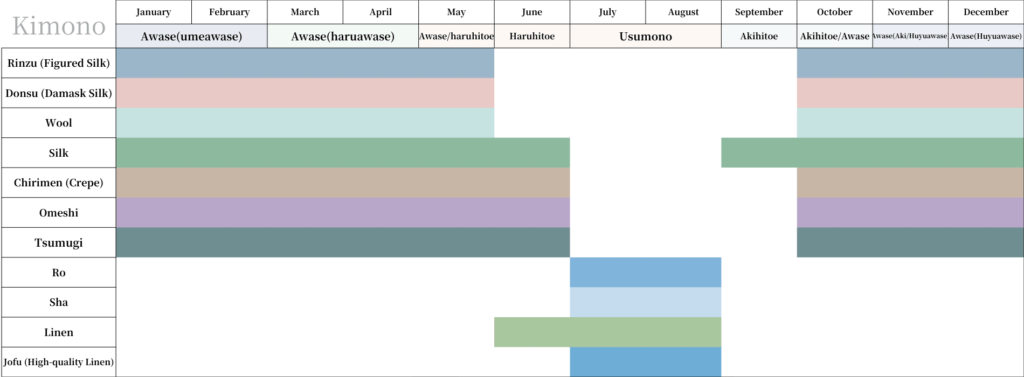
It is fundamental to enjoy kimono by changing the tailoring and material with each season.
Awase (lined kimono) can be worn for the longest period, from October to the following May, and is widely used for everything from daily wear to formal occasions.
Hitoe (unlined kimono) is a light kimono worn during the transitional seasons of June and September, making it comfortable during humid periods.
Usumono (lightweight kimono) is a sheer kimono used during the height of summer in July and August, creating a refreshing appearance.
Furthermore, it’s also important to choose patterns and designs appropriately.
It is considered stylish to incorporate elements of the coming season slightly early, which helps to beautifully express the changing of the four seasons.
By knowing these basics, you can further enjoy coordinating your kimono to reflect a sense of the seasons.
Han-eri (Collar) & Nagajuban (Undergarment)
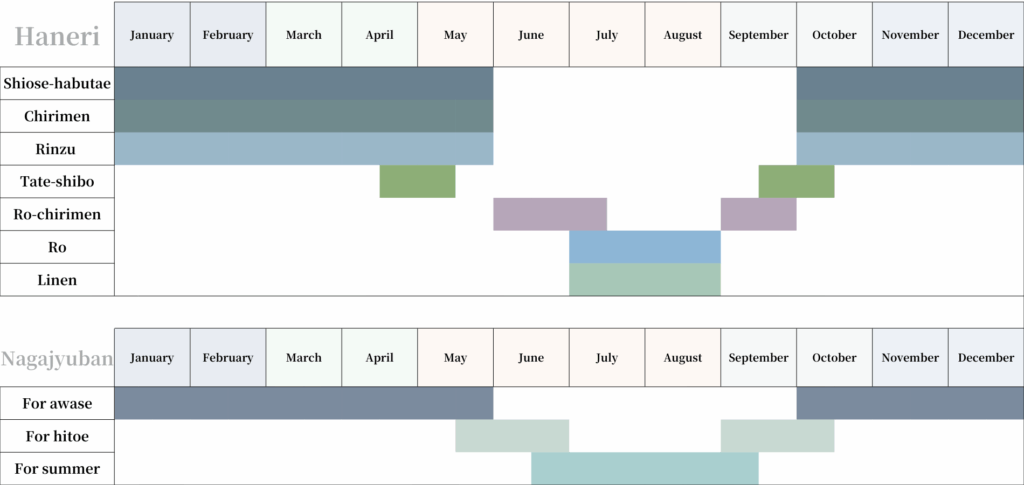
・Shiose-habutae (Salt-glazed silk) ・Chirimen (Crepe) ・Rinzu (Figured silk) ・Tate-shibo (Vertical crepe)
・Ro-chirimen (Gauze crepe) ・Ro (Gauze weave)
・For awase (lined kimono) ・For hitoe (unlined kimono)
By choosing the material of your han-eri to match the season, you can significantly enhance the impression of your kimono.
In summer, using a ro or ma-ro han-eri creates a cool and refreshing atmosphere, giving your look a sense of crispness. From autumn to spring, shiose han-eri are a standard choice and can be matched with a wide range of kimono from around October to May. In winter, ro-chirimen han-eri are a great fit, adding warmth suitable for the cold season. By selecting the material of your han-eri for each season, you can naturally express a sense of the season in your kimono coordination.
It is also fundamental to change the material and tailoring of your nagajuban according to the season. For colder periods, use a thick fabric with a lining, while in summer, choose a thin, sheer material. Thin nagajuban are especially suitable from June to September, and it is standard to wear them during the height of summer in July and August.
It’s also desirable to match colors and patterns to the season. Bright pastel colors and cherry blossom patterns, for example, look beautiful in spring. By matching your materials and designs to the season in this way, you not only create a look of coolness or warmth but also significantly improve your comfort.
Obi (Sash)
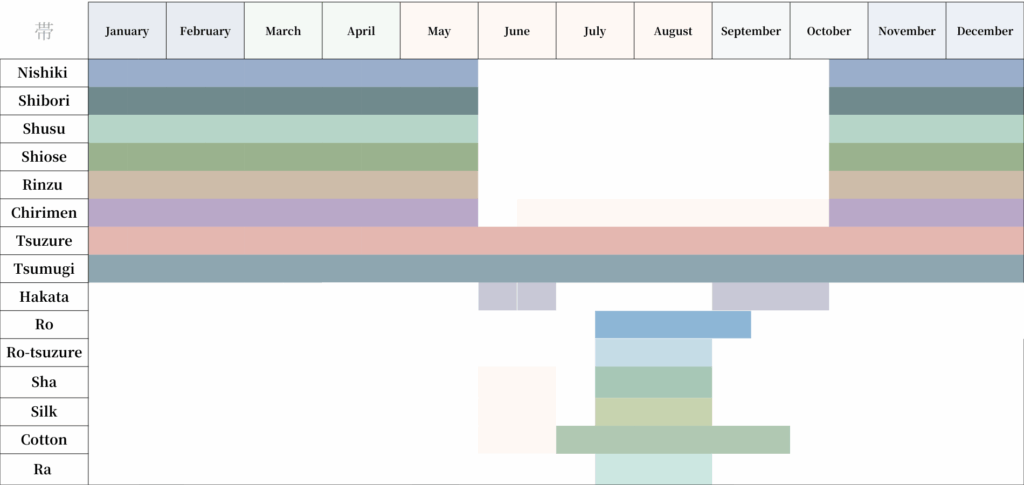
・Nishiki (Brocade) ・Shusu (Satin) ・Rinzu (Figured Silk) ・Chirimen (Crepe) ・Hakata (Unlined Hakata)
・Ro-tsuzure (Gauze Tapestry) ・ Ro (Gauze Weave) ・Sha (Silk Gauze ・Ra (Openwork Silk)
By choosing the material and design of your obi to match the season, you can add greater depth to your entire outfit.
In spring, patterns of cherry blossoms and wisteria look beautiful and will make your seasonal style stand out if worn from late March to early April. In summer, sheer materials and cool colors are preferred. Choosing a breathable obi will make you more comfortable.
In autumn, patterns that evoke a sense of harvest, like autumn leaves and chrysanthemums, are suitable. Warm materials and colors will also enhance your look. In winter, an obi with motifs of pine trees or snow is appropriate, and cooler-toned designs will give you a crisp, elegant impression.
In this way, by selecting the pattern and material of your obi to suit the season, you can further enjoy the beauty and harmony of your entire kimono ensemble.
Obiage & Obijime

Obiage with a sheer texture are considered suitable for summer and humid seasons and cannot be used all year round.
On the other hand, obijime without a sheer texture are said to be usable throughout the year.
However, for casual outfits, thick or wide obijime tend to look heavy in summer, so choosing a thinner one will better match the season.
Haori & Coats
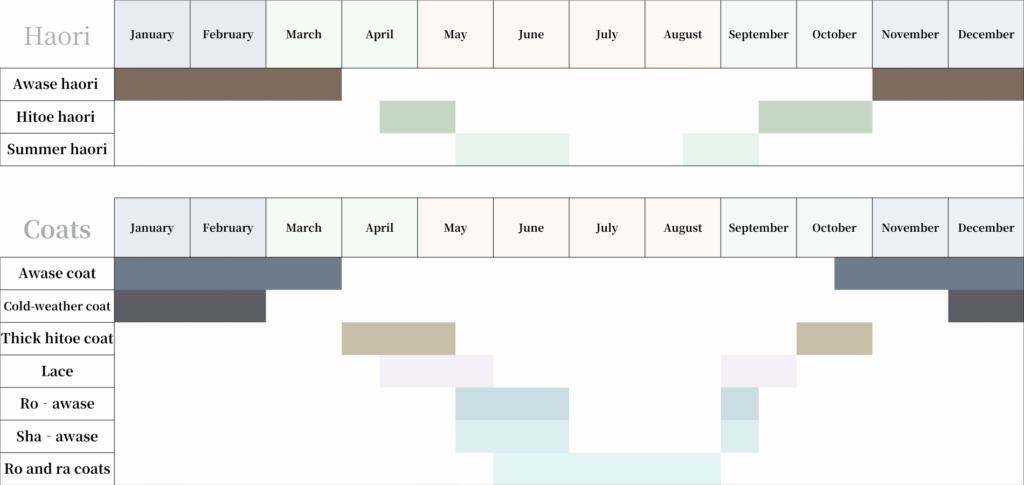
・Awase haori (Lined haori) ・Hitoe haori (Unlined haori)
・Awase coat (Lined coat) ・Ro and ra coats (ro and ra are types of sheer silk)
Outer garments such as haori, michiyuki coats, and douchu-gi are typically worn starting around the time the autumn leaves change color.
However, due to regional climate differences, there’s no strict rule about what month you should start wearing them. The time of autumn leaves varies between Hokkaido and Kyushu, so it’s a good rule of thumb in the kimono world to remember to start wearing them “when the leaves change color.”
Haori and coats are generally worn until the cherry blossom season, and it’s said their role ends around early April. In warmer regions, it can get hot as early as March, so people may take off their haori or coats before the cherry blossoms even bloom.
Nowadays, these items are popular not just for warmth, but also for protecting your kimono from dust and as a stylish accessory. Lightweight haori and coats made from materials like mon-sha, organza, or lace are particularly in demand.
Conclusion
Koromo-gae is not merely about adjusting your attire for the temperature; it is a vital part of Japanese culture that reflects the four distinct seasons.
By incorporating a sense of the season into everything—from the tailoring of your kimono (awase, hitoe, usumono) to accessories like the obi, haori, nagajuban, and han-eri—your entire look will become much more refined.
Using a monthly guide and your local climate as a reference, it can be fun to creatively get a head start on the coming season.
Choosing your kimono to align with the seasons helps to cultivate a connection with nature and adds vibrant color to your wardrobe.
